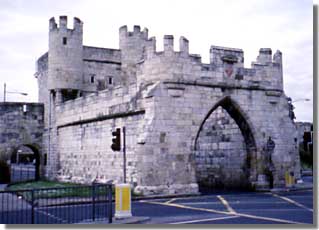
Walmgate Bar is the most easterly of the gates of York's medieval wall. It is the only gate still to retain its barbican (the outer extension prominently seen in this shot), a fourteenth century addition which originally ran over a water-filled defensive ditch. Heads of those executed for treason were stuck on pikes which were mounted atop this gate, as a public warning.
By at least the latter part of the fourteenth century, the gatehouse was being rented out by the city to private citizens. It was perhaps this residence that was in 1478 assigned, rent-free, to a mason as part of the terms of his employment as a civil servant with the duty to "view and oversee yearly the walls of this city and all defaults therein to show and declare to the mayor and chamberlains of the time being, and he at all times to have and receive for him and his servants labouring on the said defaults such wages as belong to a mason to take daily." [The York House Books 1461-1490, ed. L. Attreed, 1991, vol.1 p.139; language modernised somewhat by me.] That the previous tenant was also a mason may reflect a similar, less formal arrangement.
Providing for a city's defence was not just a matter of building strong surrounding walls. It was necessary to furnish the gates with barriers such as portcullises (as Walmgate Bar had, and still has today). When Richard Spynk funded the improvement of Norwich's defences in the fourteenth century, this included provision for portcullises, wooden doors reinforced with lead, bars and chains for the entranceways (presumably when the doors were open), 28 springalds with ammunition for each, and a special defence for the river access into the city at the south end. By the end of the century, small cannon were being used to defend city walls. In the context of the civil war, ca. 1463, York took measures to repair the walls and the guns of the city and to buy supplies of gunpowder. By 1487, however, the citizens were petitioning the king to send them some of the royal armaments to augment city defences; Henry VII arranged for 12 serpentines, with gunpowder, to be transferred from Scarborough.
At the same time, the heads of each city ward were ordered to have the citizens of their wards assemble, armed and armoured, at a specified location for a "view of arms" by the mayor. This was a further essential element of city defence: the allocation of responsibility for defence of particular gates and stretches of wall to one or more wards and wardens – or, in 1380, to parishes and constables – and the provision of guards at each gate overnight in times of threat. Under the Assize of Arms (1181), reinforced by the Statute of Winchester (1285) each adult freeman had to provide himself with certain arms and armour, according to his financial means, and each hundred was to hold a review of the armed militia twice a year. Some townsmen (the information here coming from mid-14th century Norwich records) were wealthy enough that it was expected they be able to equip themselves with a full set of body armour suitable for a foot-soldier: breastplate with a padded undergarment such as a doublet, a bascinet helmet with neck protection (aventail), and brassarts and gauntlets to protect arms and hands. Others were only partly armoured (arm protection being the most dispensable item), while others had no armour, only weapons: usually a sword, dagger and staff or cudgel, although some specialized as archers.
